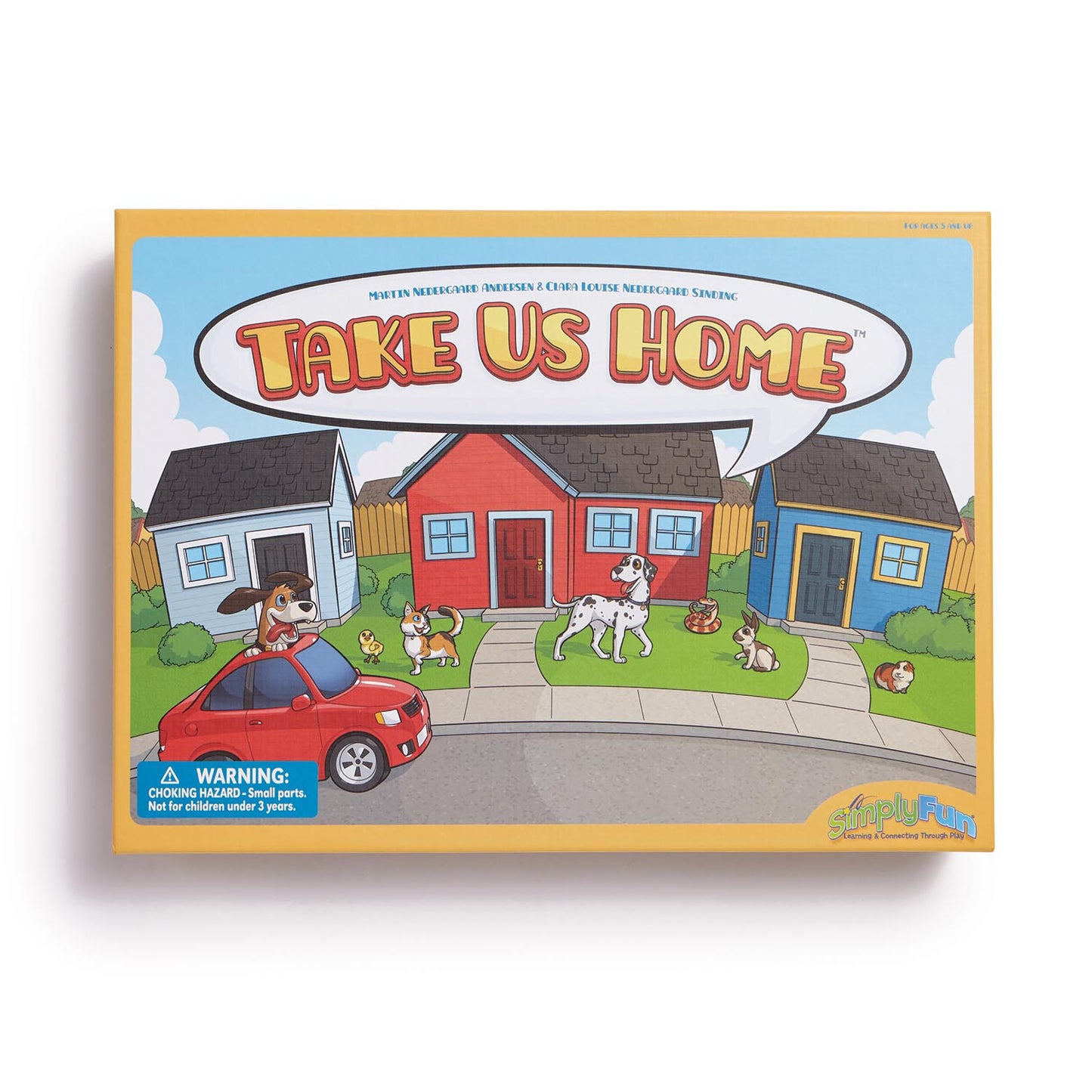
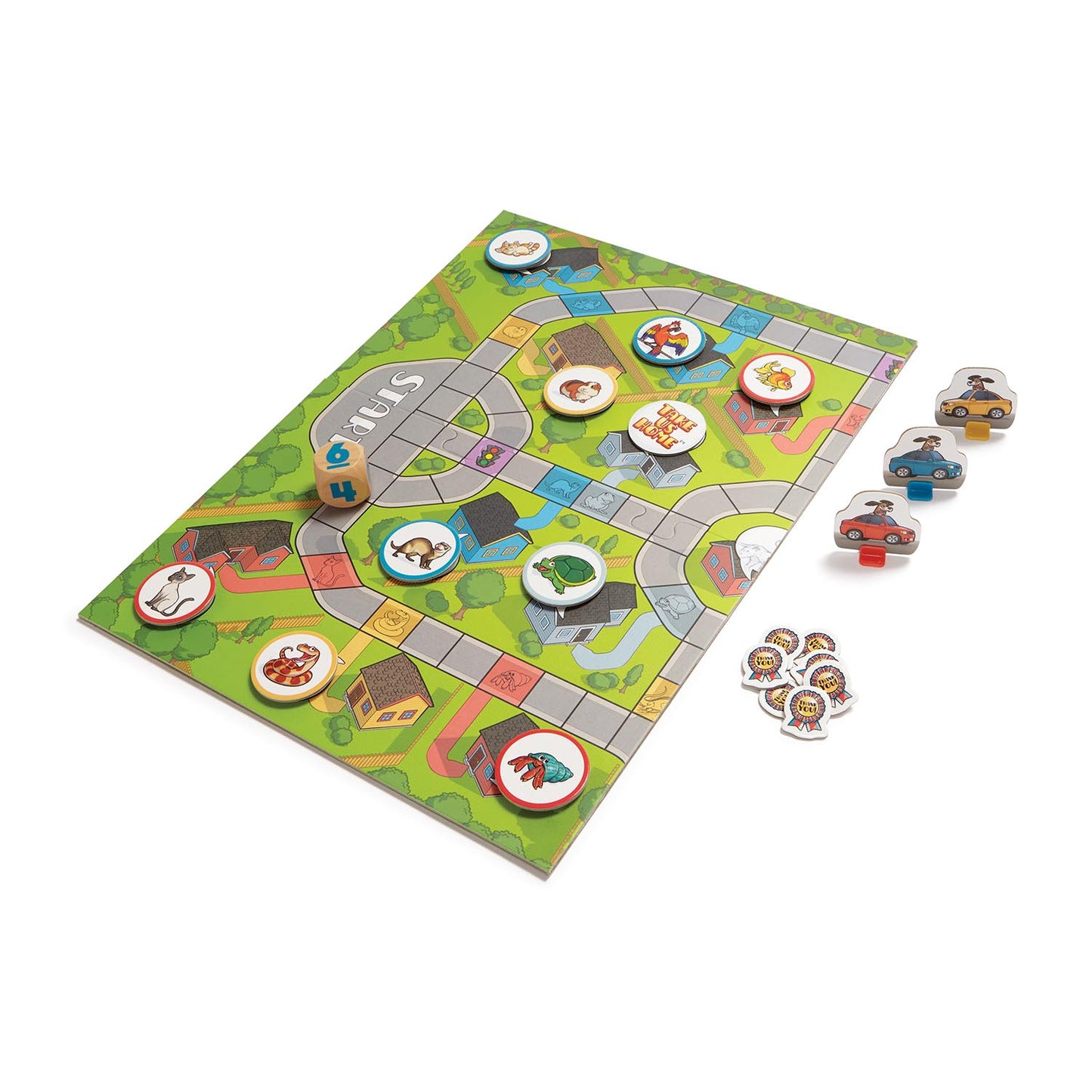
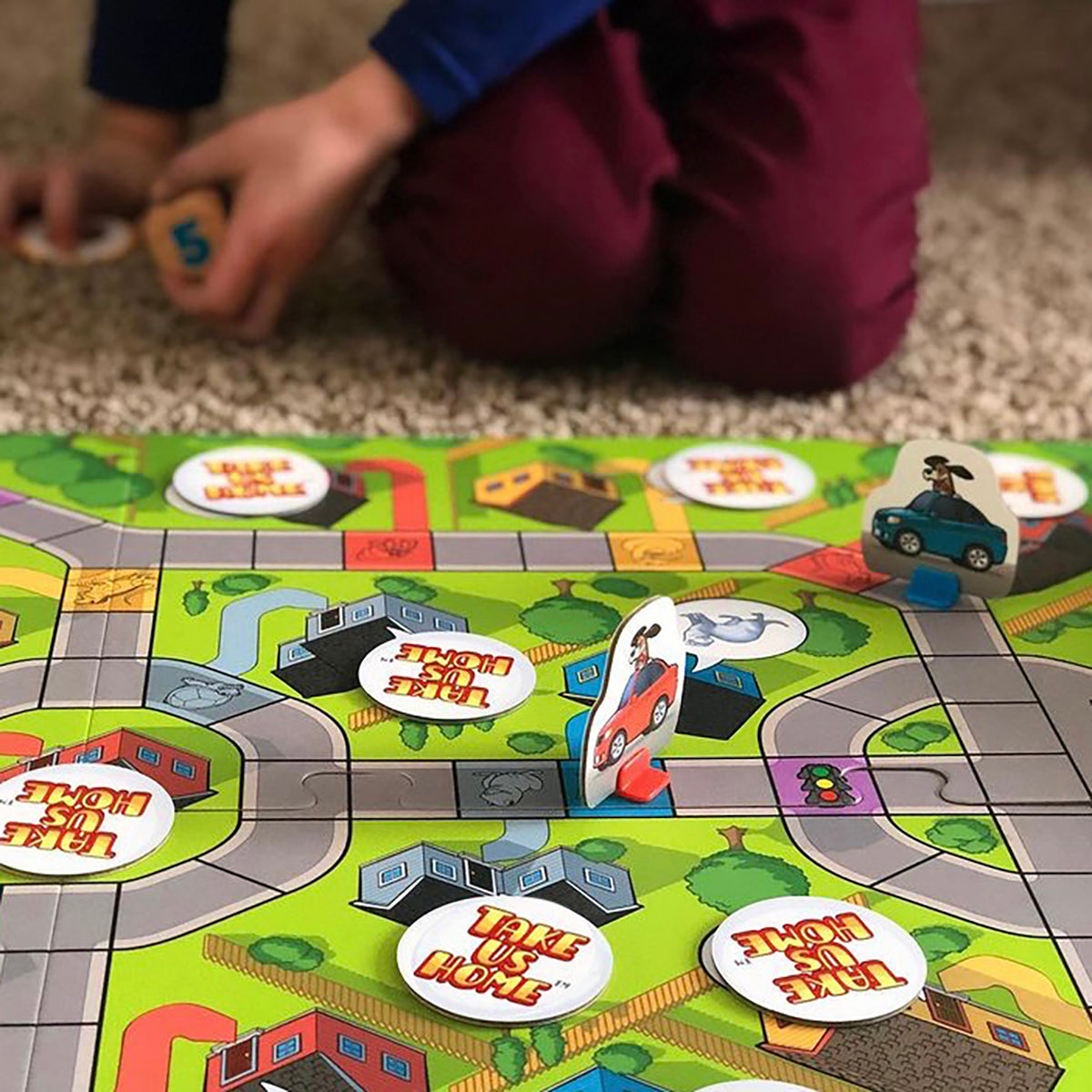
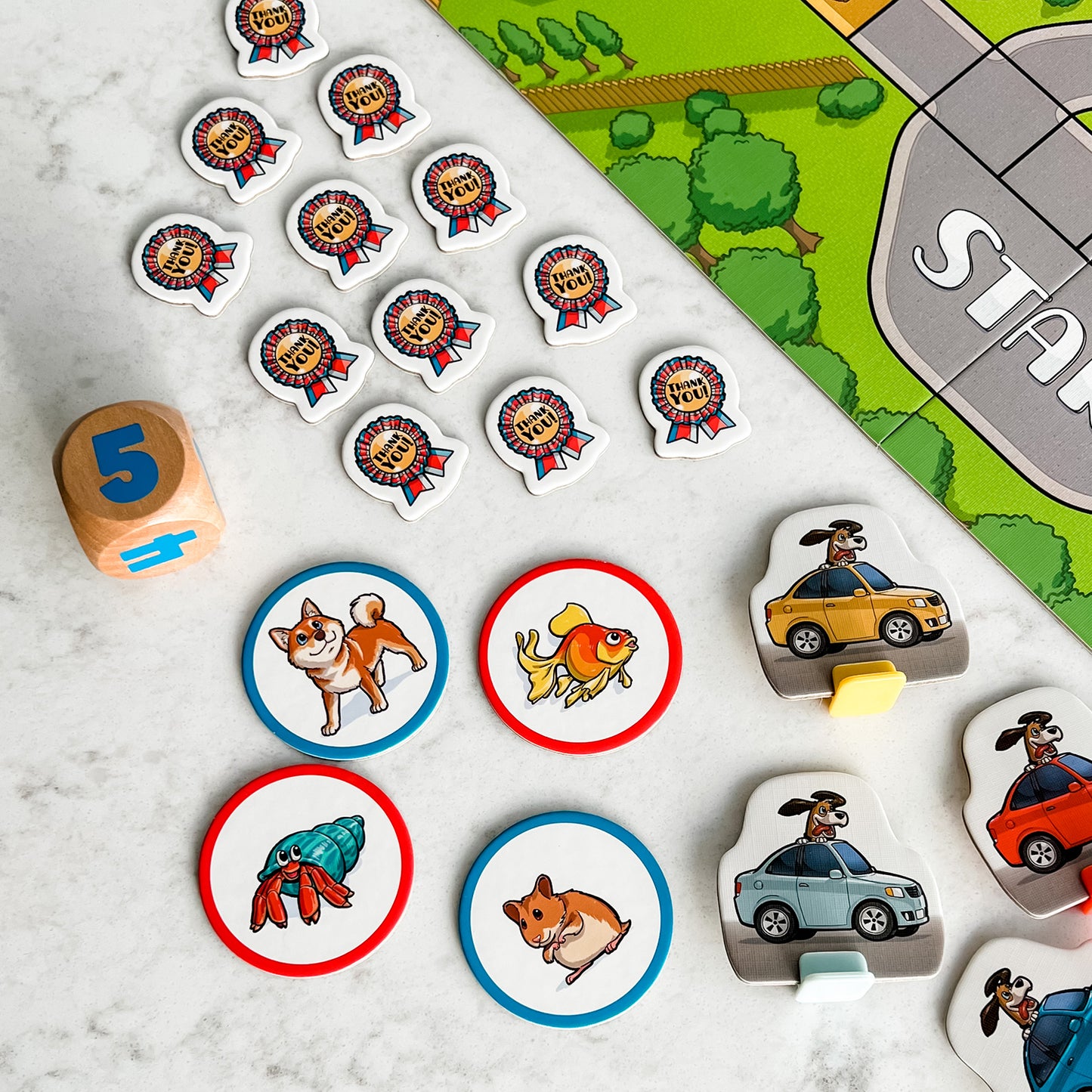
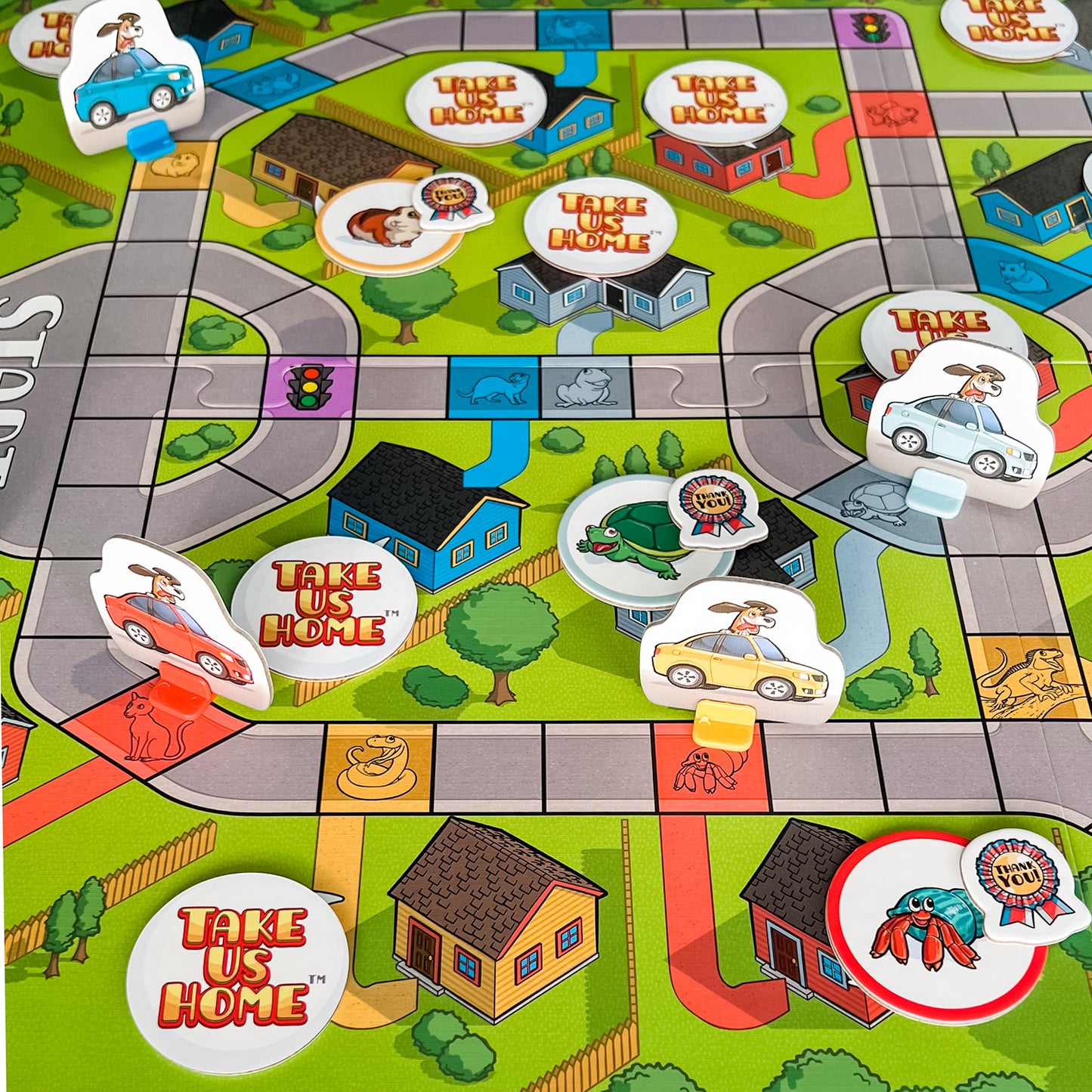
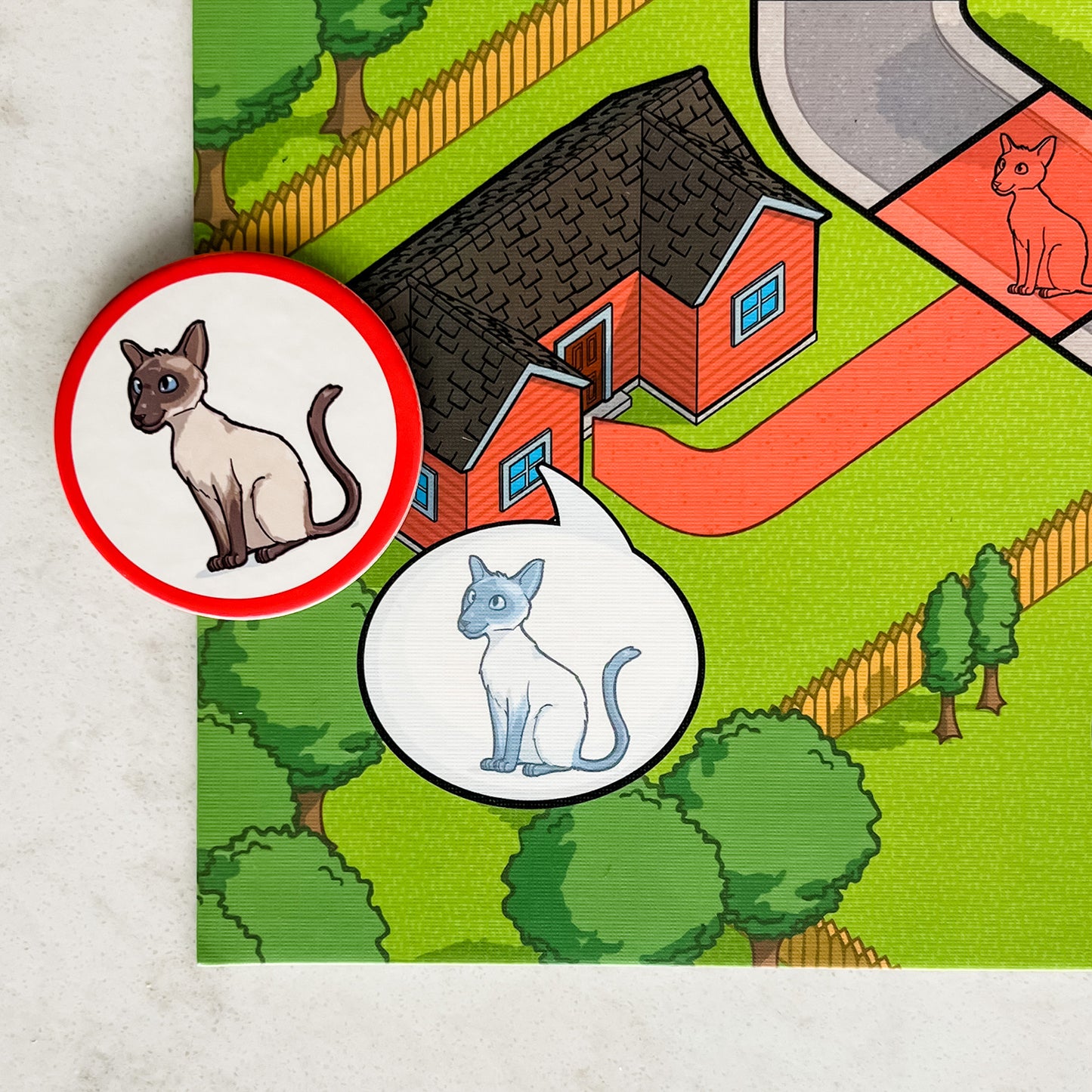
Collapsible content
Our pets went out to play but they got lost and we have to bring them home. Digger the Dog knows the way, and we’ll help him with our counting and matching skills as we learn to play Simply Fun’s Take Us Home.
Take Us Home is game for 2 to 4 players and is great fun for people ages 5 and up.
In every Take Us Home game box, you’ll find 1 neighborhood board, with houses where all the pets live.
You’ll also find 22 pet tiles with 22 different animals that got lost when they went to play.
There are 4 Digger the Dog cars to bring the lost pets home.
1 wooden die tells how many spaces to move.
And there are 25 Thank You tokens that players get for helping a pet find its way home.
To set up the game, place the board in the center of the table by assembling the two pieces like a puzzle.
Shuffle all 22 pet tiles and place each one face down on a different home. NO PEEKING!
Let each player choose a Digger Car and place them on the start space on the board.
Set out the die and the thank you tokens.
Now you’re ready to play Take Us Home!
To start the game, the first player rolls the die and moves his card that number of spaces in any direction. When moving from the start space, he may move directly into any of the 5 spaces next to it.
If the player lands on a gray road spot, he must stay there and wait for his next turn to roll again.
If the player lands on a stoplight, he gets a bonus roll and rolls again to move up to twice the number of spaces.
If the player lands on a space that is already occupied with another player’s car, he must either have a high enough roll to pass that car or stop on the space before it. Only one car is allowed on each space.
If a player lands on a space showing a pet, he then looks at the house to see if there is a pet tile there. If there is, and it says Take Us Home, he may pick it up from the board and place it, pet side up in front him. He’s just found a lost pet, and on the next turn, he and Digger will start the journey to take it home.
Note that players may not pick up any more pets until the one they have is taken home and placed pet side up on the house. That means the pet is home.
If there is no pet tile at the house that means the pet has already been picked up. Or if the pet tile is animal side up, that pet is already safely home. Players then continue their journey to a different home with a tile that says Take Us Home.
To take a pet home, look for the picture on the path in front of the house that matches the Pet Tile picked up. When a player lands on this space, they have taken the pet home! But wait a minute. He must first look to see if there is a pet tile already at the house.
If there is a tile already there, and it says Take Us Home, the player must swap it with the tile in front of him. As a reward for returning the pet, he receives one thank you token, and the pet tile picked up is the next lost pet to take home. Players store and save all their thank you tokens to be counted at the end of the game.
If there is no pet tile over the house, the player simply places his tile, pet side up, over the house and receives a thank you token for returning the lost pet. He must now go find another one.
After each player rolls the die and makes his move, it’s the next player’s turn. Players continue taking turns until all the pets are returned to their homes.
Once all the pets are returned and no players have any Pet Tiles in front of them, the game is over and it’s time to tally the score.
The player with the most Thank You tokens wins the game! If there is a tie, the winning players share the victory.
You’ll learn a lot and help Digger take all the lost animals safely back to their owners with Simply Fun’s Take Us Home.


Core Standard*: None


Explore
What Does Child Do To Use Skill In The Game?
Players examine the Take Us Home game board looking for pets to pick up and take to their proper home.
How Parents Can Assist Learning
When first learning the game, parents can help children look for the best path. After children pick up an upside down Pet Tile, encourage them to look at going forwards and backwards to find the fastest path to the pet's proper home.
Learning Implications and Educator Support
When first learning the game, educators can help children look for the best path. After children pick up an upside down Pet Tile, encourage them to look at going forwards and backwards to find the fastest path to the pet's proper home.
Determine
What Does Child Do To Use Skill In The Game?
Take Us Home involves plenty of determining as players decide where to move their Digger Car, what to do when landing on a space, the fastest path to take a pet home and where they can retrieve another face down Pet Tile.
How Parents Can Assist Learning
When first learning the game, parents can help children look for the best path. After children pick up an upside down Pet Tile, encourage them to look at going forwards and backwards to find the fastest path to the pet's proper home.
Learning Implications and Educator Support
When first learning the game, educators can help children look for the best path. After children pick up an upside down Pet Tile, encourage them to look at going forwards and backwards to find the fastest path to the pet's proper home.
Compare
What Does Child Do To Use Skill In The Game?
Players compare their Pet Tile with all of the homes on the game board to find the proper home for their pet. Players also compare alternative paths in order to pick the best one to get a pet to the correct home or pick up a face down Pet Tile.
How Parents Can Assist Learning
If children are having difficulty finding the proper home, give directions such as "The bunny lives in a red house" or "The bunny lives near the fish."
Learning Implications and Educator Support
Comparing is one of the primary skills developed playing Take Us Home. It focuses a child's attention to the details of the animal's shape, since the Pet Tile is colored yet the matching image on the game board is grey scale. If children are having difficulty finding the proper home, give directions such as "The bunny lives in a red house" or "The bunny lives near the fish."
Remember
What Does Child Do To Use Skill In The Game?
Take Us Home involves light memory skills as players need to remember what happens based on the spot their Digger Car lands.
How Parents Can Assist Learning
While no special adult support is required, a parent may want to demonstrate what happens on each space several times to ensure younger children understand.
Learning Implications and Educator Support
While no special adult support is required, educators may want to demonstrate what happens on each space several times to ensure younger children understand.
Predict
What Does Child Do To Use Skill In The Game?
Based on the moves of others, players can start to predict which Pet Tiles they may be able to get before someone else does.
How Parents Can Assist Learning
Predicting involves skills like analysis, observation, empathy and interpretation. No adult support required. Parents can encourage children to predict to which homes they think other players are trying to move their Digger Cars.
Learning Implications and Educator Support
Predicting involves skills like analysis, observation, empathy and interpretation. No special educator support required. Teachers can encourage children to predict to which homes they think other players are trying to move their Digger Cars.
Plan
What Does Child Do To Use Skill In The Game?
Players look for Pet Tiles to obtain and homes to take their pets. In both cases, players need to plan the fastest path they can make.
How Parents Can Assist Learning
When first learning the game, parents can help children look for the best path. After children pick up an upside down Pet Tile, encourage them to look at going forwards and backwards to find the fastest path to the pet's proper home.
Learning Implications and Educator Support
When first learning the game, educators can help children look for the best path. After children pick up an upside down Pet Tile, encourage them to look at going forwards and backwards to find the fastest path to the pet's proper home.
Solve
What Does Child Do To Use Skill In The Game?
As the game proceeds, player's need to make simple strategic decisions of which face down Pet Tiles to pursue.
How Parents Can Assist Learning
Encourage children to ""Wait. Look. Think."" This will help with impulsivity, considering options and looking closely. In particular, you want children to look at where other players are moving their Digger Cars. Also, using such cues can give children a model for future play in order to think more strategically.
Learning Implications and Educator Support
Take Me Home introduces basic strategic thinking for young children. They need to determine which Pet Tiles to pursue in order to accumulate the most Thank You tokens. This requires looking and evaluating the positions of other players, which are constantly changing throughout the game. Encourage children to "Wait. Look. Think." This will help with impulsivity, considering options and looking closely. Also, using such cues can give children a model for future play in order to think more strategically. "
*Data compiled from CCSSI ELA Standards, WA Science Standards, and Washington Social Studies Standards


Cognitive
Suggestions for How to Modify Play Experience
Players need to match pictures of animals, recognize numbers on the dice, and be able to move a token with one-to-one correspondence. Players need to understand the meaning of the different pictures and symbols on the board along with corresponding actions. Players with cognitive delays can play with prompting and support from other players.
Ask questions with each move to see if the child understands what to do. With repeated play the child will learn the meaning of the symbols.
Communication
Suggestions for How to Modify Play Experience
Although the game can be played without communication, encourage children to count aloud and comment on what they intend to do on the board.
Use the topic of pets to encourage players to talk about their favorite animals, discuss the characteristics of each, and comment on moves in the game.
Sensorimotor
Suggestions for How to Modify Play Experience
The Digger Cars and Pet Tiles are large and thick. Unless children have serious issues with manipulating small objects, they should be able to pick up the Pet Tiles.
The Thank You tokens are small, so other players may need to assist with picking them up.
Social Emotional/Behavioral
Suggestions for How to Modify Play Experience
This is a simple game, that allows children to succeed and feel accomplishment with each pet they return home. If children are impulsive, encourage them to look for the shortest route before they move their token.
Vision
Suggestions for How to Modify Play Experience
Take Us Home will be challenging for children with vision concerns. Line drawings of animals on the board will be difficult to distinguish. To help children with vision concerns, place a Thank You token on the house where the player is headed. This will provide a goal marker for the player, and they retrieve the Thank You token when they arrive at the house.
Hearing
Suggestions for How to Modify Play Experience
Players do not need to talk, but will want to comment on their animals and moves they are making. Use sign language if possible.
*Data compiled from CCSSI ELA Standards, WA Science Standards, and Washington Social Studies Standards


Autism Strengths & Interests
Short Summary of Strengths & Interests
- Can match pictures.
- Can recognize written numbers to 6.
- Has good spatial understanding.
Is good at matching visual items
Is This Game Appropriate? Yes
Description
Once children land on an pets picture on the board, Take Us Home requires children to find the matching picture on the board and move around the board to return the pet to his home.
Has a good memory for words, phrases and dialouge
This game is not appropriate
Has a good memory for pictures, numbers and patterns
This game is not appropriate
Likes to put things in order or a sequence
Is This Game Appropriate? Yes
Description
Matching pictures of pet is a key part of Take Us Home. Players also need to study the path patterns to determine the shortest way home. Children with these strengths will do well with Take Us Home.
Learns through visualizing or "replaying" actions in their mind
This game is not appropriate
Likes activities with rules, such as math and phonics
This game is not appropriate
Is very concrete and literal
This game is not appropriate
Learns in small "chunks" (for example, phone numbers are 3 chunks of number xxx-xxx-xxxx that are combined together)
Is This Game Appropriate? Yes
Description
Take Us Home uses pictures of pets and their matching homes, with paths for moving Digger's car. This game is good for children who need straight forward literal games.
Is good at nonverbal reasoning and logic
This game is not appropriate
Likes spatial problem solving
Is This Game Appropriate? Yes
This game is not appropriate
Can read well with good vocabulary, though may not fully comprehend content
Is This Game Appropriate? Yes
Description
Spatial problem solving is needed to determine the shortest route home or to choose the next pet to take home.
Likes to use and has good fine motor skill
This game is not appropriate
Likes established routines or set ways of doing things
Is This Game Appropriate? Yes
Description
Moving Digger's Car token along the path and picking up the Pet Tiles and Thank You tokens requires some fine motor skill.
Likes manipulating, constructing or building things
Is This Game Appropriate? Yes
Description
Each turn follows the same routine, so Take Us Home is very predictable. Once the game is played, the child will understand the pattern of play and look forward to the next round!
Likes to use and has good musical abilities
This game is not appropriate
Likes to use and has good drawing skills
This game is not appropriate
Autism Special Considerations
Appears to ignore other's communication and/or has difficulty giving eye contact to a communication partner
Is This Game Appropriate for Child with Characteristic? Yes
Can Child with Characteristic Play Game w/o Modification? Yes
Strategies for Developing Compensatory Skills:
Take Us Home does not need communication or eye contact to play.Players concentrate on the path and the symbols on the board during each turn.
Has difficulty understanding complex verbal directions
Is This Game Appropriate for Child with Characteristic? Yes
Can Child with Characteristic Play Game w/o Modification? No
Strategies for Developing Compensatory Skills:
There are several rules and symbols on the board that players need to understand, such as not passing another player, knowing when a pet has been picked up, knowing that the stop sign means an extra turn. However, each of these can be explained as the game is played.Ask children to explain what is happening as they move around the board. This will let others know if the child understands the rules.
Uses vocabulary inaccurately or demonstrates echolalia (repeating another's speech)
Is This Game Appropriate for Child with Characteristic? Yes
Can Child with Characteristic Play Game w/o Modification? Yes
Strategies for Developing Compensatory Skills:
Echolalia should not interfere with the game, as long as the child is not too far off topic. Try to point out and talk about what is happening on the board. This will provide a focus for conversation.
Gets stuck repeating a verbal topic or physical actions and/or has difficulty attending to others' actions or topic.
Is This Game Appropriate for Child with Characteristic? Yes
Can Child with Characteristic Play Game w/o Modification? No
Strategies for Developing Compensatory Skills:
If the child has repetitive actions unrelated to the game, give the child a "fidget toy" or provide a desired action or toy between toys. Also provide opportunity for everyone to move after a round of turns.
Has difficulty producing speech/communication
Is This Game Appropriate for Child with Characteristic? Yes
Can Child with Characteristic Play Game w/o Modification? Yes
Strategies for Developing Compensatory Skills:
Communication is not necessary but should be encouraged.Give children choices to encourage talking. For example, "You landed on a stop sign. Do you stop or roll again?"
Has difficulty sequencing multi-step actions and/or doing complex abstract tasks
Is This Game Appropriate for Child with Characteristic? Yes
Can Child with Characteristic Play Game w/o Modification? Yes
Strategies for Developing Compensatory Skills:
Tasks in Take Us Home are concrete, requiring simple movements. Take Us Home uses a range of pets that serve as concrete motivators for finding their matching homes.
Demonstrates difficulty initiating and maintaining social interactions
Is This Game Appropriate for Child with Characteristic? Yes
Can Child with Characteristic Play Game w/o Modification? Yes
Strategies for Developing Compensatory Skills:
Children can play the game without having social interactions, but other players can encourage interaction and discussion about the pets, moves, and path choices. Encourage players to comment on each others' plays.Ask questions to encourage interaction.For example, "Jon went down this path, which path would you take? This one or this one?"
Acts out or demonstrates avoidance behaviors when frustrated, overwhelmed, or needs more sensory input.
Is This Game Appropriate for Child with Characteristic? Yes
Can Child with Characteristic Play Game w/o Modification? No
Strategies for Developing Compensatory Skills:
If avoidance behaviors occur, interject additional play.For example, after each round let players take turns thinking of movements or actions all players need to do together such as "Everyone touch your knees 10 times!"
Has short attention span for non-preferred activities
Is This Game Appropriate for Child with Characteristic? Yes
Can Child with Characteristic Play Game w/o Modification? No
Strategies for Developing Compensatory Skills:
If a child is not interested in the game, use preferred activities as reinforcers between turns.For example, "After my turn we are going to all do an action that Adam likes. Then it will be Sara's turn in the game."
Needs sameness or consistent routines and/or has difficulty with transitions from one activity to another
Is This Game Appropriate for Child with Characteristic? Yes
Can Child with Characteristic Play Game w/o Modification? Yes
Strategies for Developing Compensatory Skills:
Take Us Home is consistent.Actions don't change within a turn. Use the child's favorite pet tile to transition the child to the game
Has difficulty understanding others' feelings, intentions, and the reasons for others' actions.
Is This Game Appropriate for Child with Characteristic? Yes
Can Child with Characteristic Play Game w/o Modification? Yes
Strategies for Developing Compensatory Skills:
Although the child does not have to pay attention to the other player's actions or feelings, the game provides an opportunity for the persons playing with the child to demonstrate excitement, frustration, determination, sadness, worry, etc. Model and exaggerate these emotions and talk about each player's feelings during each turn.Also, comment on actions to draw the child's attention to what is happening.
*Data compiled from CCSSI ELA Standards, WA Science Standards, and Washington Social Studies Standards


Extra Ways to Play the Game
This variation is for 2 or 4 players. Either one player or teams of two players sit opposite of the other with game board between them. Each player places their Digger Car on the path circle closest to the player (the "path circle" is one of the two similar spaces on the board where Digger Cars are usually placed to start the game). All tiles are placed face up rather than face down. The rest of the traditional rules apply. Ultimately, players or teams of two scramble to get the most total pets.
Materials Needed
No additional materials needed.
Developmental Benefits
This team version encourages players to communicate about which paths to take to maximize their opportunities against the other team. The team that takes home the most pets wins.
Extra Ways to Play the Game
Make an exception to the rule of not landing on the same spot as another player. The person with the least pets can land on same spot as any player who is currently trying to take a pet home. By doing this, the player steals the other player's "take home" pet and takes it home them self.
Materials Needed
No additional materials needed.
Developmental Benefits
This modification adds an element of surprise to the game.
*Data compiled from CCSSI ELA Standards, WA Science Standards, and Washington Social Studies Standards
- Choosing a selection results in a full page refresh.
- Opens in a new window.







